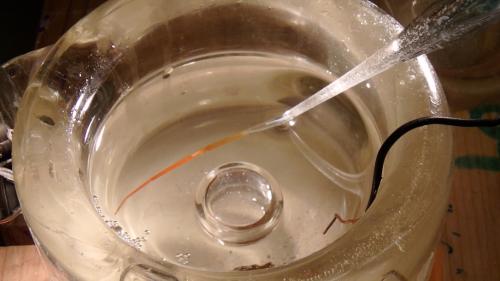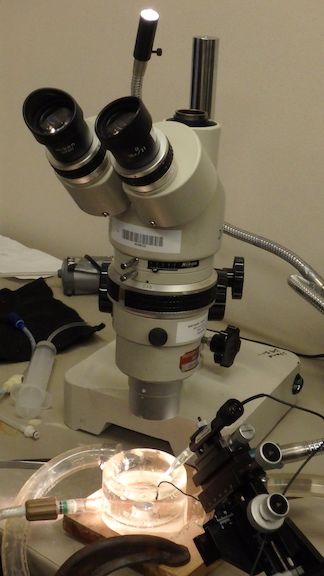Steven Lane stares down the eyepieces of a dissecting microscope as he deftly adjusts small knobs on a desk-top instrument mount to his right. Lane, a graduate student at the University of Montana, is carefully threading the tip of a glass oxygen-measuring electrode inside the detached leg of a sea spider. Once the probe is in place and secured, Lane bubbles nitrogen gas into the small dish of recirculating, cooled seawater, holding the spider leg and electrode. The nitrogen removes dissolved oxygen in the seawater outside of the sea spider leg and as the oxygen inside the leg travels down its concentration gradient and diffuses out of the leg, Lane can calculate a physical characteristic of the sea spider exoskeleton, called its "diffusion coefficient."
 Steven Lane examines a sea spider cuticle specimen.
Steven Lane examines a sea spider cuticle specimen.
Oxygen is a necessary reactant for metabolic processes, but it needs to get inside almost all cells to reach the respiration structures inside - organelles called "mitochondria" - and in almost all cases, this occurs through diffusion. Diffusion is the tendency of molecules to move from areas of high concentration, down a concentration gradient, until they reach a uniform concentration throughout an area or volume. Fundamentally, all animals must find a way to manage this physical property as it relates to oxygen, and many do it through specialized structures like lungs, gills, skin, or trachea (in insects). Each of these structures does its best to put oxygen in close proximity to tissue, so that diffusion of oxygen can occur quickly, gases can be exchanged rapidly, and metabolism has plenty of oxygen to use as a reactant.
 A glass oxygen electrode inside a sea spider leg gives a reading of the difference in oxygen inside the leg compared to outside.
A glass oxygen electrode inside a sea spider leg gives a reading of the difference in oxygen inside the leg compared to outside.
Lane is exploring how respiration influences body size as animals go from being small to being large. If an animal's tissue thickness increases in proportion to its increasing body size, it would mean an increase in the time it takes oxygen to diffuse through that tissue and a decrease in the amount of oxygen that can be delivered. This is particularly important for sea spiders because the animals diffuse oxygen directly through their exoskeletons (called their "cuticle"), which is thicker the bigger they are. It turns out that sea spiders get around this problem by increasing the size of oxygen-permeable pores all over their cuticle as the animal gets bigger. The numbers Lane derives from his diffusion experiments let him generate a maximum size for Antarctic sea spiders. While the largest one we've captured is roughly 22grams/~1oz and 14inches/35cm across, Lane calculates that they can reach almost five times that weight. Theoretically, of course.
 Working under the microscope is a delicate endeavor and requires a steady hand.
Working under the microscope is a delicate endeavor and requires a steady hand.

Comments